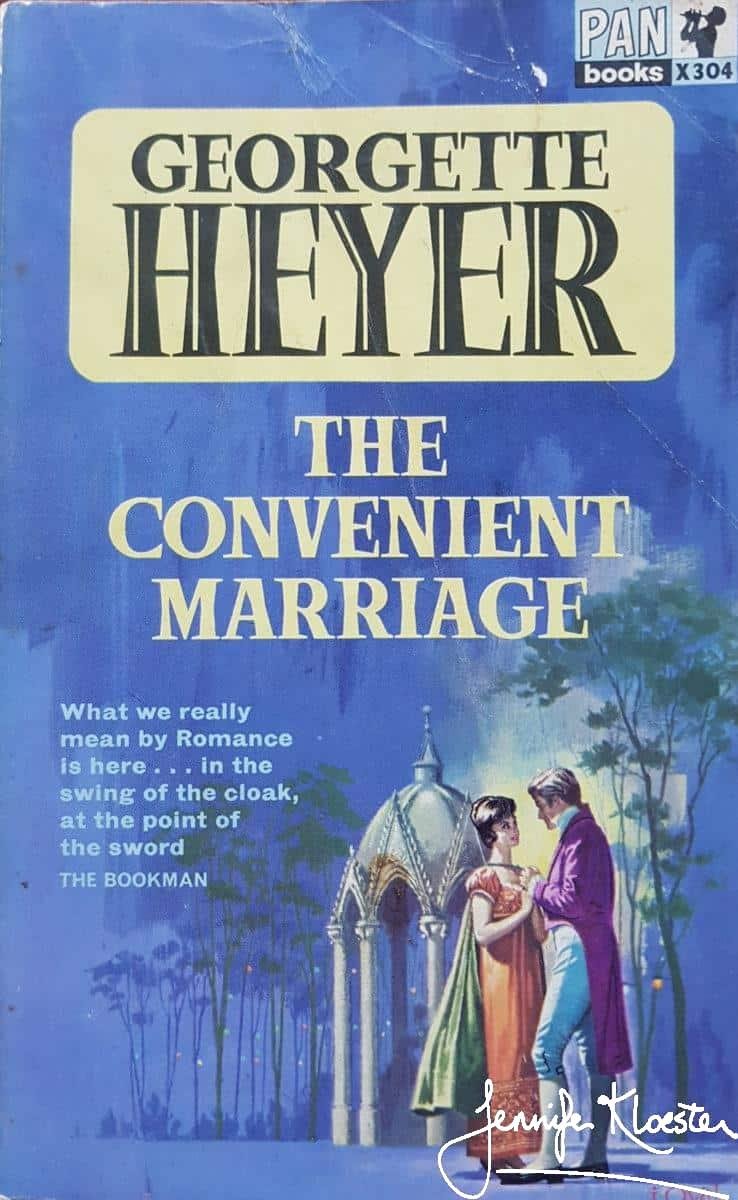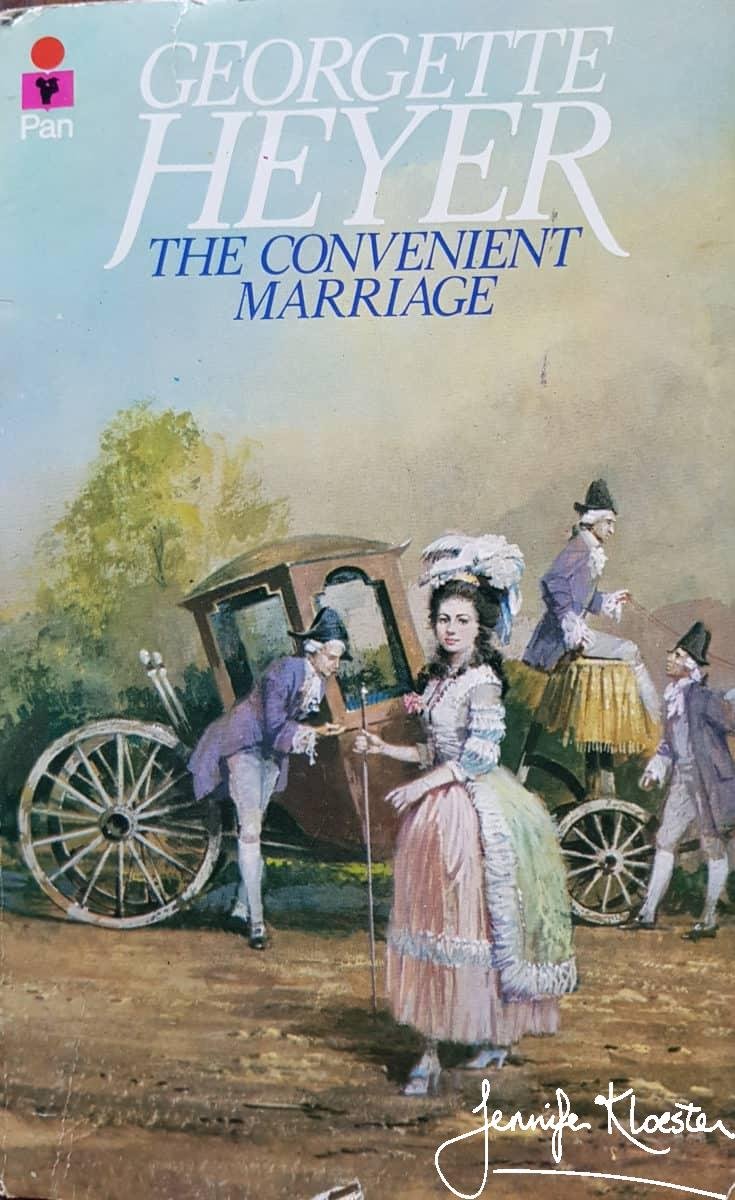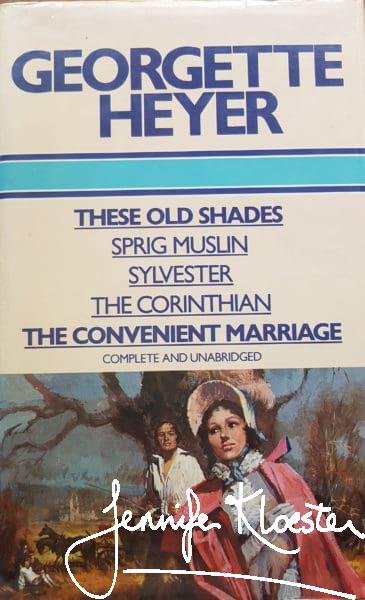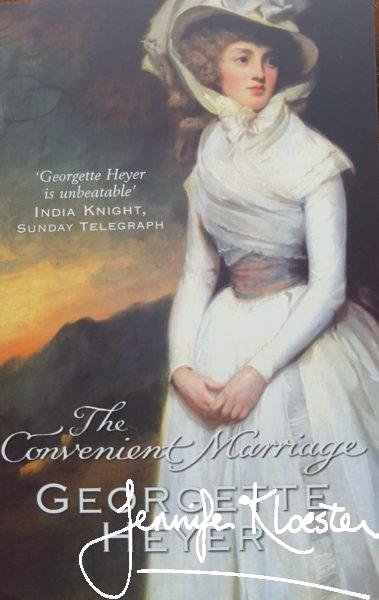
By May 1933, Georgette and Ronald, with baby Richard, had left Southover, their rented house in Colgate, and moved into the Sussex Oak in Warnham, a couple of miles from Horsham. The seventeenth-century inn was to be their home for some weeks while they looked about the neighbourhood for a long-term rental. Richard was now 15 months old and an engaging child. The lease on Southover had expired and his parents wanted somewhere more permanent to raise him. From his infancy, Georgette had employed a nurse or a nanny to help care for Richard, an approach to child-rearing that was very much in the British tradition, but one that was also necessary if she were to continue writing. In 1933, she published only one book, Why Shoot a Butler?, and this was no doubt due to her having given birth the previous year. Though Ronald was still running the sports store in Horsham, his income was not enough to cover their expenses and Georgette knew that she needed to write two books a year until she had established a large enough royalty stream to support their lifestye. In 1934, the first of those two books would be The Convenient Marriage.
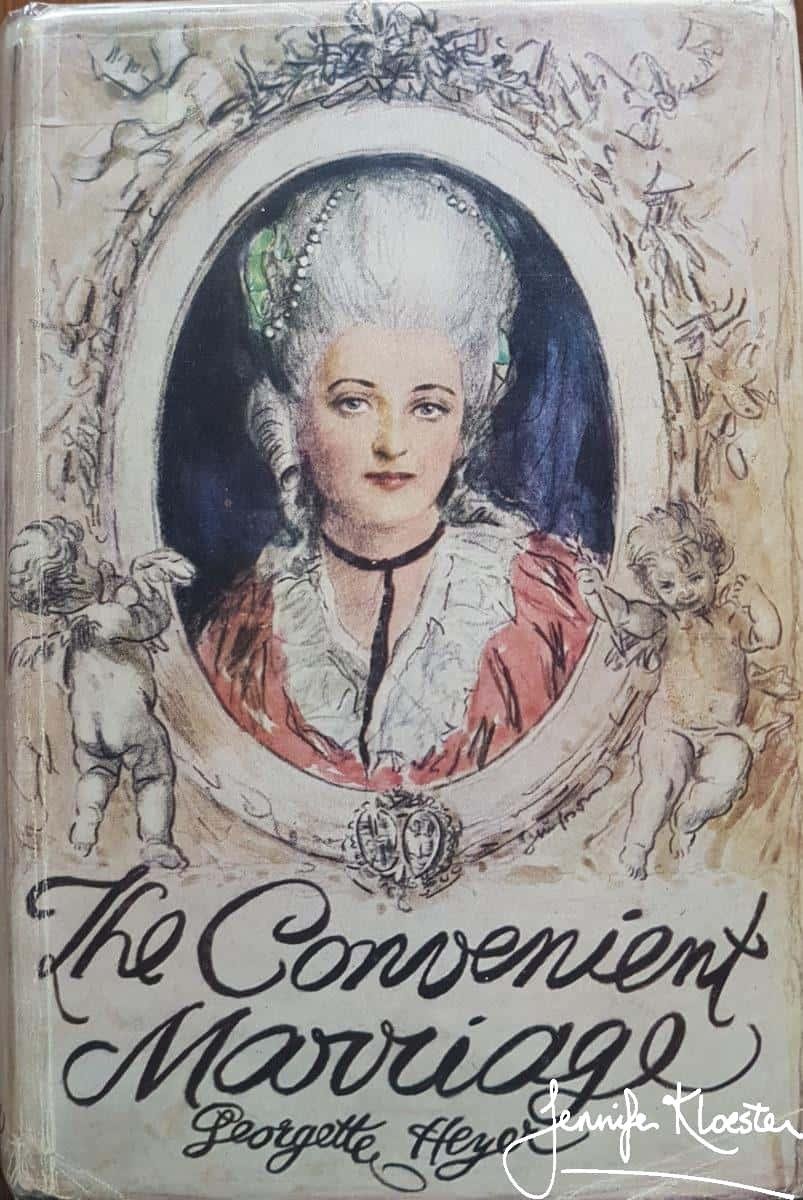
“I’m thinking of calling it The Convenient Marriage. O.K.?”
The new novel was to be her sixteenth book and her sixth story set in the eighteenth century, with all the colour and glamour intrinsic to the period with its fabulous clothing, face patches, jewel-encrusted shoes and extravagant headwear. The hero (surprisingly) is ‘an exquisite’ whose (unsurprisingly) ‘laced and scented coats concealed an extremely powerful frame’ and who, on the surface at least, cares far more for the cut of his top-boots, the choice of his coat (dos de puce or blue velvet?) and the style of his wig (the perruque à bourse or the Catogan?) than for the matters of state in which his earnest young secretary, Arnold Gisborne, wishes he would take an interest. Heyer is so clearly at home in the era and, despite the fact that she was living in a country inn when she wrote the first third of The Convenient Marriage and did not have her library about her, she easily created a sense of period in this gently humorous historical novel. Heyer always read widely and the literary influences in her novels are many with a decided predilection for the works of Shakespeare and Jane Austen. Indeed, the scene where the youthful and impetuous newly-married Countess of Rule visits her family after her honeymoon is reminiscent of the newly-married Lydia Bennet’s return to Longbourn in Jane Austen’s Pride and Prejudice.
At first glance she seemed to her sisters to have changed out of all recognition. Evidently the day of demure muslins and chip hats was done, for the vision in the chaise wore a gown of tobine striped over a large hoop, and the hat perched on top of curls dressed à la capricieuse bore several waving plumes.
Georgette Heyer, The Convenient Marriage, Pan, 1966, p.56.
A “stylish romantic comedy”
The Convenient Marriage is the first of Georgette Heyer’s novels in which the hero and heroine are married early in the story. Marcus Drelincourt, Earl of Rule, is 35, bored and handsome. Horatia (Horry) Winwood, aged 17, is the youngest of three sisters, one at least of whom must marry money. It is the eldest, the beautiful Miss Elizabeth WInwood, who has reluctantly agreed to sacrifice the man she loves, Edward Heron – a mere lieutanant and an impecunious younger son – and marry Rule in order to save the family fortunes. But it is the youngest, Horry, who risks scandal by visiting the Earl at his home and offering herself in marriage in place of her sister. With consummate skill Georgette Heyer sets up this fantastic story in the first twenty pages and carries it off with such style that the story quickly evolves into one of her delicious confections of wit and intrigue. As Heyer’s first biographer, Jane Aiken Hodge, said The Convenient Marriage ‘glows with the with the kind of stylish romantic comedy that was to be her hall-mark’.
Written with pen and ink
In the first two decades of her long career, Georgette Heyer often wrote at night, frequently staying awake until dawn writing with a fountain pen on the pages that would become her next novel. In the modern world where computers allow writers to edit, delete, cut and paste, etc. at the touch of a button and to create multiple drafts of their stories, it is hard to imagine writing with pen and ink which must have made rewriting so laborious. It is possible – perhaps even likely – that the pen-and-ink process itself helped to ensure that for many authors early drafts were often close to or actually final drafts. This does seem to have been true for Georgette Heyer whose ability to write quickly and to pen first drafts that were often final drafts was extraordinary.
“I’m glad you like my excerpts”
Staying at the Sussex Oak must have had its challenges, but it does not seem to have affected Georgette’s creativity. It is not known if she wrote The Convenient Marriage in her bedroom or at a table in one of the public rooms of the old inn, but wherever she wrote it, the words came easily and in such flowing style that she was prompted to write out several excerpts and send them to her agent, L.P. Moore, for his entertainment. A perusal of these excerpts show them to be identical to what eventually appeared in the published book – something many authors would envy and editors would find incredible!

‘this highly scintillating letter”
Georgette’s idiosyncratic handwriting where the ‘e’s look like ‘a’s and the running script is sometimes difficult to decipher, but it is so much more interesting than a typed letter or an email. In letters to friends or close associates she often used a stream-of-consciousness style as she does here when telling her agent how writing the letter ‘is holding me back from the book you expect to receive this month’ and asking him if she should refill her pen. Then the ink changes from light to dark and we are in the moment when Georgette has stopped writing, refilled her pen, and returned to her letter to tell him she has done so. How vividly one can imagine her doing that!
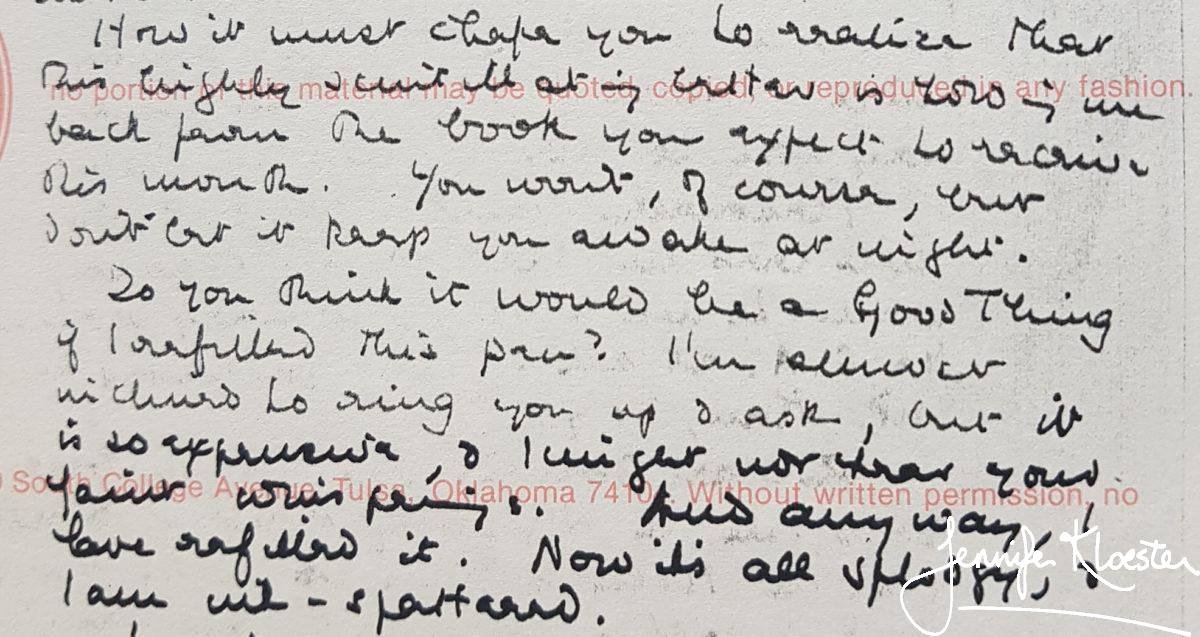
‘How it must chafe you to realize that this highly scintillating letter is holding me back from the book you expect to receive this month. You won’t, of course, but I shouldn’t let it keep you awake at night. Do you think it would be a Good Thing if I refilled this pen? I’m almost inclined to ring you up & ask, but it is so expensive, & I might not hear your faint whisperings [Moore had lost his voice]. And anyway, I have refilled it. Now it’s all splodgy, & I am ink-spattered.’
Georgette Heyer, letter to L.P. Moore, written at the Sussex Oak, Warnham, 27 May 1933.
The dramatis personae for The Convenient Marriage
As well as writing out ‘choice excerpts’ for Moore, two weeks earlier Georgette had also written out her dramatis personae for his edification. This was usually how she began her books: she would think up several characters, give them names (her characters’ names were always vitally important to her) and come to know their personalities and characteristics and then drop them into a scene. From there, her characters would then act according to their various natures and the story would evolve, with each character following their natural story-arc until the book’s inevitable and satisfactory end. Heyer’s characters lived for her and she would talk about them to her agent as if they were real people: ‘isn’t it sad about Caroline Massey? Not a Nice Woman at all’.
‘Would you like to hear my Dramatis Personae? No? Well, it’s too late now, you’ve got to.
Marcus Drelincourt, Earl of Rule. Hero of the best type. Very pansy, but full of guts under a lazy exterior. Aged 35.
Elizabeth Winwood, lady in the best XVIIIth cent. tradition. Sweet & willowy. Age 20
Charlotte Winwood. Improving spinster. 19
Horatia Winwood. A stammering heroine, of the naïve & incorrigible variety. 17
Pelham, Viscount Winwood. Brother to above ladies. Young rake & spendthrift. Provides light relief.
Maria, Viscountess Winwood. Mother to all the above Winwoods. An invalid of exquisite sensibility.
Edward Heron. Lieutenant of the 10th Foot, invalided home from Bunker’s Hill. Enamoured of Elizabeth.
Louisa, Lady Quain. Trenchant sister to Rule.
Sir Humphrey Quain. Her husband.
Arnold Gisborne. Secretary to the Earl of Rule.
Caroline, Lady Massey. I regret to say, Rule’s discarded mistress.
Crosby Drelincourt. Cousin & heir-presumptive to the Earl of Rule. A Macaroni, & a nasty piece of work, taken all round.
Robert, Baron Lethbridge. Best type of villain. Fierce & hot-eyed & sardonic.’
Georgette Heyer, letter to L.P. Moore, written at the Sussex Oak, 10 May 1933.
“Yes, but I’ve Stuck”
In writing most of her novels, Heyer would eventually get ‘stuck’, coming to a place where she had no idea what her characters were going to do next. This happened with The Convenient Marriage and, on telling Ronald about it, he merely said, ‘”Ah! I’ve been waiting for that”‘ before enumerating to her ‘all the Sticking places in all the books I’ve written ever since I married him’ . Ronald also confidently told Georgette that she would very likely ‘surmount this obstacle’ just as she had always done. Where she had become stuck was in chapter three where the hero, Lord Rule, goes to visit his mistress, Lady Massey. Georgette described the problem to Moore with her tongue firmly in her cheek:
‘Yes, but I’ve stuck. Here I am, in Lady Massey’s boudoir (all rose pink and silver, you know), & I can’t either talk to her, or get away. The trouble is I’ve led such a sheltered life. It’s a frightful drawback, & I do think young females about to embrace a literary career ought to get to know a few good demi-mondaines. Personally, I can’t make out what Rule sees in that odious Massey. She seems to me a very ordinary woman. No S.A. [sex appeal] at all. But you never know with Men, do you?’
Georgette Heyer, letter to L.P. Moore, written at the Sussex Oak, 27 May 1933
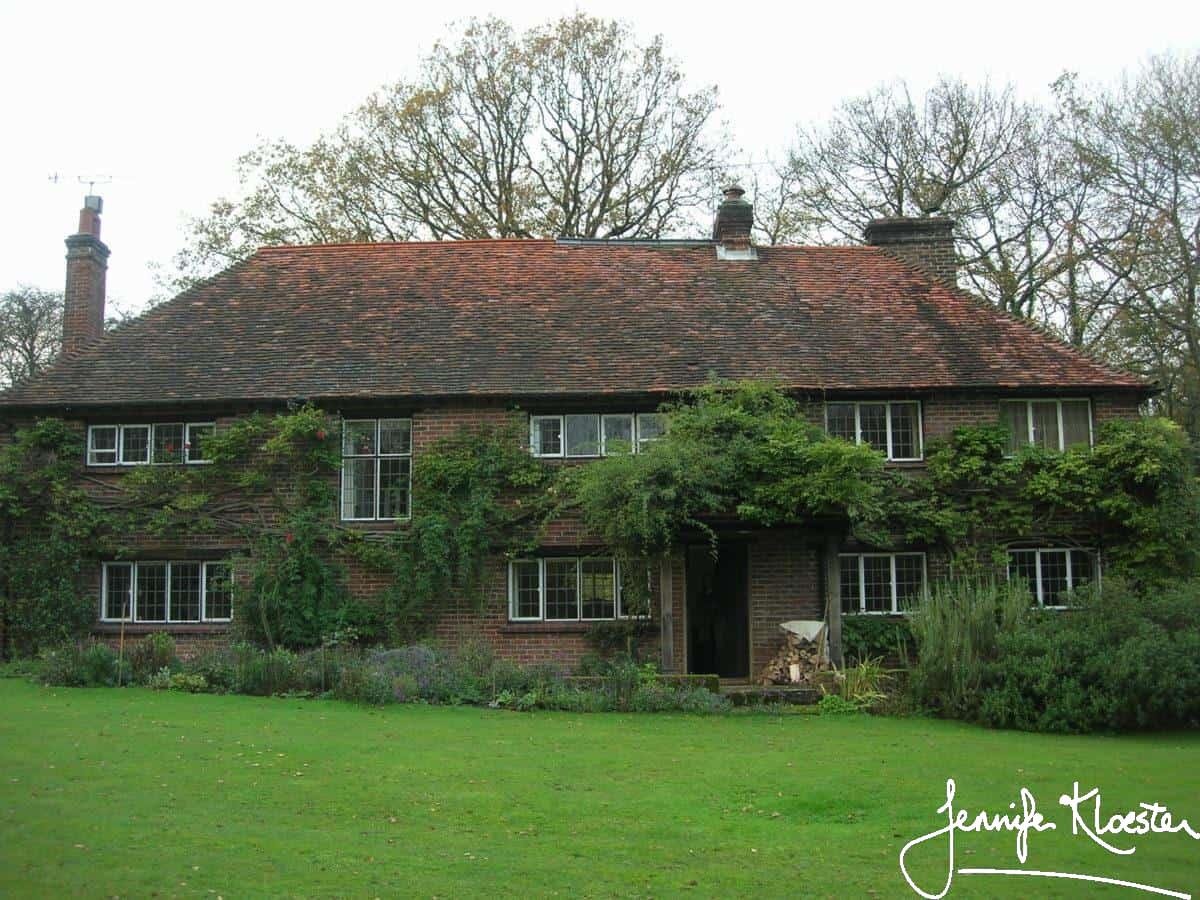
The move to Blackthorns
Georgette and Ronald eventually found the perfect home to rent. This was Blackthorns, a large, red-brick house, set at the end of a long driveway in 15 acres of garden, a wood in which nightingales sang, a stream, a pond and a well. Large trees meant you could not see the house from the road making it very private, which exactly suited Georgette. It was also close enough to Horsham, some four miles away, to be convenient for shopping, the cinema and for Ronald’s work. Georgette finished writing The Convenient Marriage at Blackthorns and over the next six years she would write another dozen novels there. Richard spent his formative years at Blackthorns, before being sent to boarding school at the age of nine. His parents loved him but he was often lonely as his mother was busy writing. She adored him, however, and would often mention him in her letters to Moore or other friends. When he was 15 months old Georgette wrote humorously of Richard’s apparent attitude to The Convenient Marriage:
Richard ‘doesn’t care for the book. He does like a Womanly Woman, & thinks that a Mother’s Place is in the Nursery.’
“Georgette Heyer is a Better Writer than You Think”
Heinemann published The Convenient Marriage in February 1934. From the first it sold well and has since had many reprintings. Georgette inscribed one of her advance copies to her beloved great-aunts, Cissy and Jo. Forty-five yearsafter its publication, in 1969, the author, A.S. Byatt, wrote the first serious appraisal of Georgette Heyer. It appeared in Nova magazine under the heading “Georgette Heyer is a Better Writer than You Think” and in it she offered her reasons for Heyer’s success:
‘I think the clue to her success is somewhere here–in the precise balance she achieves between romance and reality, fantastic plot and real detail. Her good taste, her knowledge and the literary and social conventions of the time she is writing about all contribute to a romanticised anti-romanticism: an impossible world of prettiness, silliness and ultimate good sense where men and women really talk to each other, know what is going on between them and plan to spend the rest of their lives together developing the relationship. In her novels, as in Jane Austen’s, it is love people are looking for, and love they give each other…
A.S. Byatt, “Georgette Heyer is a Better Novelist than You Think”, Nova, August 1969.
Just a few of the reasons to read Georgette Heyer!



